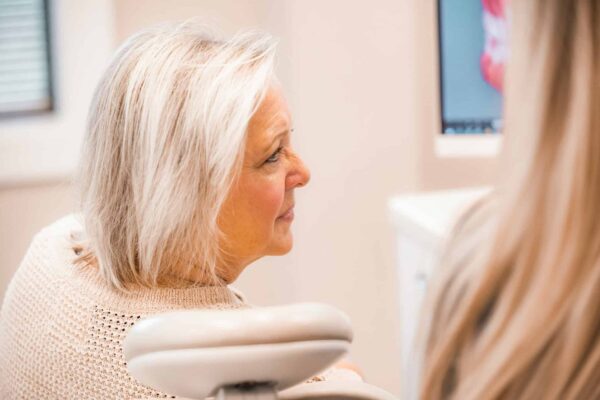When you hear us talk about “plaque,” we’re not talking about one of those cool trophies you get for being awesome. This type of plaque isn’t nearly as cool. In fact, it’s pretty bad because it can lead to gum disease, infection, and tooth loss. Dental plaque isn’t a good thing, but there is one good thing about it — it’s completely preventable!
Smiles by the Bay wants to help you keep your smile beautiful — not just during your treatment, but after as well. We know how important it is to clean plaque off teeth, especially if you have braces. We know that heavy plaque on braces can lead to white spots on your teeth after removing your braces. That’s why we want to do all we can to help you keep plaque off your teeth while we help you shape the smile of your dreams!
Common Questions About Dental Plaque
We’ve heard many questions about dental plaque from our patients in the Annapolis, Kent Island, and Denton, MD areas. People may be confused about what plaque is, how it forms, and how to prevent it. Let’s answer a few of those questions!
What Is Dental Plaque?
Dental plaque is that sticky, nasty film you get on your teeth that makes your teeth feel “fuzzy.” In actuality, it’s a substance created by the breakdown of sugars and starches in your food by bacteria that live in your mouth. That substance settles on the surfaces of your mouth, including your teeth and gums.
If plaque isn’t removed, it will begin to break down the enamel, the hard coating of your teeth. This is called tooth decay. Eventually, it will eat its way through the enamel, causing cavities. Those cavities could reach the inner portions of the tooth where the nerves and blood vessels exist, causing pain and infection. Without proper treatment, you could end up losing your tooth.
Does Plaque Build Up Every Day?
We know what you’re wondering. “Why do I wake up with plaque on my teeth every morning? Is plaque bad for my teeth?” The answer to the second question is easy: Yes. Dental plaque is bad for your teeth because it can cause gum disease, tooth decay, and all kinds of nasty things. Unfortunately, you wake up with plaque on your teeth every morning. Why? Because you have twice as much bacteria at work when you sleep as you do during the day! They’ve coated your teeth, gums, and tongue with plaque by the time you wake up.
If you have braces, you’re not immune from plaque. You can have heavy plaque buildup on braces, just like your teeth. Plaque buildup around your braces can cause discoloration of your teeth. By the time your braces come off, you have white spots on your teeth.

Gum Disease Prevention
Plaque doesn’t just lead to tooth decay. It can also cause gum disease. Gum disease may start with mild symptoms, such as redness or swelling, but it can progress rapidly. You must treat gum disease as soon as possible.
What is Gum Disease?
It’s an inflammation and breakdown of tissue at the base of your teeth. If left untreated, gum disease can lead to severe infections and tooth loss.
Some of the signs of gum disease are:
- Redness, swelling, or tenderness
- Bad breath
- Bleeding gums
- Separation from the base of the teeth
- Loose teeth
- Changes in your bite
- Changes in how dental appliances or partial dentures fit
If you’re in the Annapolis, Denton, or Kent Island, MD, areas, contact Smiles by the Bay or your dentist right away. Gum disease should be treated before it worsens and leads to serious infections or tooth loss.

Are Plaque and Tartar the Same Thing?
Gum disease is caused by a buildup of plaque, tartar, and bacteria on and around the gums. We’ve told you about plaque, but what is this tartar we keep mentioning? It’s not the sauce stuff you eat with your seafood. This tartar is the brown or black stuff between your teeth and gums, and it’s detrimental to your oral health.
Plaque left on the teeth can form tartar that traps food particles and bacteria against your teeth and gums. This can accelerate gum disease and tooth decay. You can remove plaque yourself, but tartar requires professional cleaning. That’s why you want to eliminate plaque before it hardens into tartar.

How Do I Prevent Plaque, Tartar, and Gum Disease?
All of these things are preventable, and it’s reasonably easy to do — brush and floss regularly. The American Dental Association recommends you floss first to loosen all food particles, then brush your teeth to remove them and plaque from your teeth. This should be done twice a day for at least two minutes each time. It’s better to brush after every meal, but early in the morning and before bed are best if you can’t do that.
The second step to preventing plaque, tartar, and gum disease is to visit your dentist twice a year for a thorough examination and cleaning. Your dentist is the one who can remove tartar from your teeth, and they can also determine if there are any early signs of gum disease.
How Do I Prevent Gum Disease With Braces?
Just as you need to visit your dentist, you’ll need to see your orthodontist regularly with braces or Invisalign. When you visit Smiles by the Bay, you will get a thorough examination with leading technology to determine if there is any plaque or tartar buildup around your braces’ brackets or under your archwire and whether there are signs of tooth decay. We’ll be able to clean around your braces more thoroughly to prevent tooth discoloration once your braces are removed.
The best way to keep your braces clean and free of plaque is to do what you’d do without them — brush and floss regularly. Use a soft-bristled toothbrush and fluoride toothpaste for a good, thorough cleaning that won’t damage your braces. There are floss threaders available to make flossing much easier. Be sure to brush and floss twice daily to maintain great oral hygiene.

Gum Disease Treatment
How do you treat tooth decay and gum disease? That will depend on the severity of your gum disease. Treatment can range from a thorough cleaning to antibiotics for infection to tooth removal if the tooth has died. Your dentist will decide on your treatment.
If you are prone to tooth decay, your dentist may recommend a fluoride treatment. This puts a special fluoride coating on your teeth, which then dries and is absorbed into the enamel to strengthen it. Your dentist may also recommend a fluoride mouthwash to use at home.
Another solution is what you’re doing with Smiles by the Bay — straightening your teeth! Straighter teeth are much easier to clean and maintain. You’ll be able to keep plaque and tartar off your teeth with good oral hygiene habits. And, of course, we’ll be with you every step of the way to make sure you end up with the clean, healthy, beautiful smile you’ve always wanted!











